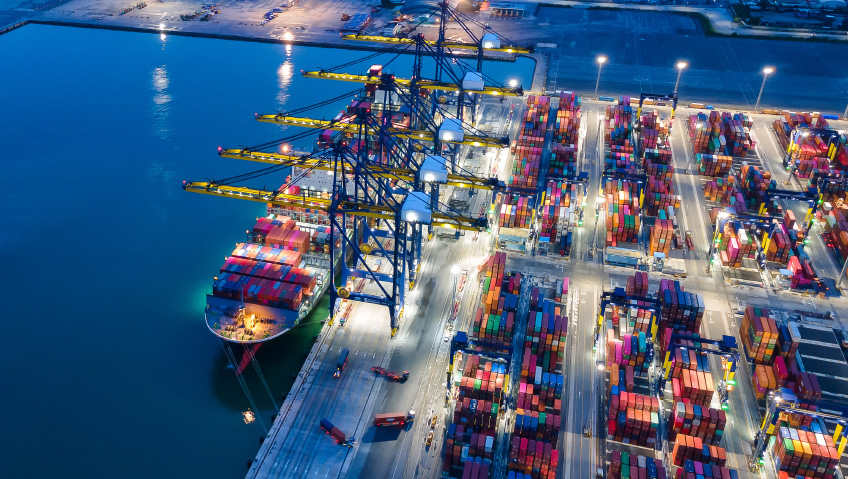The world is embroiled in a trade war that promises to destabilize the highly integrated global economy, tensions that are exacerbated by the physical wars taking place on numerous fronts. People are scared, markets are uncertain, and confusion looms, and while most businesses can withstand the tariff environment for at least a year, the longer it persists, the deeper the impact will be.
From the initial round of tariffs that the U.S. levied on its trade partners and neighbours Canada and Mexico, to “Liberation Day,” which saw an additional 180 countries slapped with tariffs, and retaliatory actions including a back and forth between China and the U.S., the outlook is grim. The stock market experienced its steepest plunge since 2020, currency values have tumbled, and trade dynamics have been permanently altered at the expense of economic competitiveness and international diplomacy.
CNBC’s “Closing Bell” co-anchor John Fortt said, “I’ve never seen anything like it,” of the after-hours market reaction that resulted in what he referred to as, “Worse than the worst-case scenario of the tariffs.”
The Budget Lab at Yale University estimated that a 20 percent universal tariff would cost the average household between $3,400 and $4,200, so with actual rates exceeding that, this is going to be a major blow to every nation ensnarled in the fight.
And amidst the fear and uncertainty, people continue to ask: what is President Trump’s end goal? Why has he chosen to turn economic partners, allies, and friends into adversaries? What does the U.S. stand to gain from these policies and how do we move forward?
Understanding tariffs and their impacts
A tariff is a type of tax imposed on imported goods by governments, typically used as a source of revenue, though since the Great Depression it has become a tool used to influence economic policy. Tariffs increase the costs of doing business and the price of goods paid for by the consumer, which leads to an onslaught of other challenges, as experienced during the Great Depression with the introduction of the Smoot-Hawley Tariff Act, which had negative economic impacts.
The historical absence of broad-based, sweeping tariffs like those imposed most recently means that no one can accurately determine the magnitude of the consequences, though it is all but promised that hard economic times are ahead. Tariffs produce an inflationary environment, slowed economic growth, and increased hardships for businesses and individuals, factors that are exacerbated with retaliatory efforts and only worsen the longer the trade war persists. Businesses have had to quickly assess their cash flow and supply chains, identify alternative suppliers, adjust pricing, diversify revenue streams, and consider new ways to make their businesses efficient.
Canadian manufacturers, for instance, face greater equipment costs, as many parts, components, and finished equipment comes from across the border, which will push the costs of doing business—and thus, prices—higher. As a result, the economy will experience a one-time permanent increase in price levels, and while businesses will absorb many of the costs in the short term, they will be passed on to the consumer in the long term. It becomes a vicious cycle that no economy will be insulated from, especially those who are intimately connected to the U.S. economy.
Tariffs will impact also impact government spending, investment, trade flows, supply chains, government revenues and gross domestic product (GDP), exchange rates, employment levels, and overall quality of life, challenges that become incrementally worse where non-tariffed alternatives do not exist, which creates an even more disruptive and inflationary environment.
Governments around the world are scrambling to create new trade relations as reduced export volumes and a weakened trade balance will lead to the depreciation of the dollar, and when employment levels and wages fall, the rising prices will become even less sustainable, which could trigger a recession or worse.
What is the end game?
Many factors could be motivating the tariff actions, but trying to put a finger on which one it is has proven difficult, especially given the steep costs that they come with.
Without question, tariffs offer a source of government revenue, and the U.S. government ran a $1.83 trillion deficit in the 2024 fiscal year, a deficit that, since his time in office, President Trump has vowed to reduce by reducing spending and introducing tax cuts, the Department of Government Efficiency (DOGE), and tariffs. What people didn’t expect was that the fight would begin with the country’s trade partners and neighbours. The President is using tariffs to put pressure on Canada and Mexico to halt the flow of migrants, illegal drugs, and weapons, which is the justification for the economic sanctions.
Currently, imports that fall outside of the United States–Mexico–Canada Agreement (USMCA) are subject to 25 percent tariffs, but if the fentanyl and immigration-related executive action was to end, they would fall to 12 percent. The challenge is, more of these goods are flowing north into Canada than they are permeating the U.S., which calls the motive into question, reports CBC News. If Canada is already doing its part to secure the border, what more can be done to free it from the impacts of the tariffs? Or is this just a guise to conceal the real reasons for doing so?
President Trump could also be posturing ahead of the 2026 review of USMCA, which was negotiated and signed during his first term in 2018. Unfair trade practices are the source of many of his qualms, and tariffs could be an economic edge in those talks.
One of the administration’s greatest priorities is to “supercharge” the domestic industrial base, which comes with its own set of challenges thanks to the tariffs, as manufacturers cannot simply walk away from existing cross-border supply chains and relationships. This is especially true of the automotive sector, which is deeply integrated across borders, as parts and components move back and forth across the border several times before they are assembled and ready for sale. If American automakers were to walk away from existing supply agreements, they could be on the hook for breakage fees of up to $500 million per U.S. factory, and there would be an even greater problem: the lack of an industrial ecosystem that can sustain a mass reshoring effort.
Labor supply and costs in the U.S. are over 20 percent higher for many manufacturers, and the lack of a skilled labor pool, paired with closure costs and timelines to get new facilities up and running, means that reshoring isn’t immediately viable. The only “hope” is that mass layoffs could trigger an oversupply that will reduce those costs and assemble an industrial reserve army that can be at the ready (a term used intentionally, as poor economic policy escalates the threat of war).
What is most likely to happen is that corporate investment will be reduced, causing investors to look elsewhere. This is what Chinese manufacturers have done in Mexico, which boasts lower operational costs, industrial infrastructure, and proximity to markets of choice. This is a major point of contention amongst the signatories of the USMCA, as many feel China is using this arrangement as a backdoor to the U.S. market, circumventing trade barriers by assembling and finishing goods in Mexico and taking advantage of the free trade agreement between the nations.
Since the mid-2010s, Chinese foreign direct investment in Mexico has accounted for a third of the investment in the country, and over the last five years, it has skyrocketed. Statistics published by Rhodium Group in 2023 show that $2.72 billion was invested in the Mexican automotive sector alone, accounting for 72 percent of China’s investment in Mexico that year. In 2024, those figures grew to three-quarters of China’s total investment.
Relations with China are of particular interest as retaliatory tariffs between the two continue to escalate, sending markets into an even greater frenzy, which has caught the attention of many who are accusing the President of manipulating the stock market through a “pump and dump” scheme, which will be difficult to prove but isn’t unreasonable to consider. The President, who has acknowledged in the past that he understands how to take advantage of the systems of government—including the tax code, which he understands “better than anybody that’s ever run for president,”—is a businessman after all, and there is money to be made.
The only difference is, as a businessman, Donald Trump is used to taking big economic risks that don’t always pan out, but as the President, it is a serious gamble at the expense of the livelihoods of many who depend on the economic cooperation and allyship of trade partners.
Anticipating impact and forging a united front
It has only been a short period of time, but the tariff environment is proving to be as aggressive as the President’s rhetoric, which includes the false claim that Canada’s economy is subsidized $200 billion by the U.S. government. What he is referring to is the trade deficit between nations, which was only $63 billion in 2024, a figure that changes with the value of oil, a commodity upon which the U.S. relies from Canada.
In 2023, Canada exported a record four million barrels per day (MMb/d), 97 percent of which was sent to the U.S., a big part of the reason President Trump has eyed it as the “51st state,” a threat to its national sovereignty that has been repeated on several occasions. The U.S. President has called for the annexation of Canada, Greenland, and the Panama Canal, by force if necessary, which supports the theory that the tariffs are a form of weaponized uncertainty to advance a greater agenda to secure control of trade routes in addition to supply chains.
People are not standing idly by waiting for economic collapse and are finding numerous ways to protest the tariffs. This is especially true in Canada where there is a renewed sense of national pride and changing consumer preferences. More than 80 percent of Canadians are changing their spending habits and showing their preference for Canadian products, reports the Financial Post, while some retailers have removed U.S. products from the shelves entirely. There is also a push to end interprovincial tariffs to promote more open trade between provinces, which would further improve access to Canadian products to offset any reduction in demand from the U.S. This is being met with global support and solidarity, even from U.S. consumers who are using their purchasing power to take a stand.
It’s working, too. Canadian manufacturers have already had to add capacity to meet growing demand, new trade alliances are being forged, and the pressure is on in the U.S. which is already feeling the pain of the boycott.
Canadians are not only keeping their retail dollars local, but they are also choosing to keep their holiday dollars local as well. According to data released by OAG Aviation Worldwide Ltd. (OAG), passenger bookings for flights between Canada and the U.S. have fallen by more than 70 percent in every month through to the beginning of October 2025, which is going to be a major blow to the U.S. tourism industry.
Companies owned by Elon Musk, the de facto head of the Department of Government Efficiency (DOGE), have also taken a serious hit. In addition to the physical damage Tesla dealerships and vehicles are targeted with, shares in the company fell 50 percent since their high, proof that people are irked by the actions of the government and that they are willing to do what it takes to show their displeasure.
Starlink has also taken a hit. Ontario Premier Ford ripped up a $100 million deal with the internet provider, banning U.S. companies from procurement contracts until the tariffs are lifted, and Mexican business magnate, investor, and philanthropist Carlos Slim cancelled a $7 billion Starlink order, pulling the full $22 billion investment plan in favor of Chinese and European offerings.
A new era of association
Amidst the uncertainty and negativity, there is a silver lining. The tariffs could be a much-needed opportunity to shake up the world economy, which has become increasingly interdependent, paving the way for stronger domestic investment and supply chains and new trade relations, which the pandemic demonstrated were very necessary.
Unfortunately, however, the tariffs have diminished one of the world’s most historic, dynamic, and interdependent relationships between trading nations at the expense the U.S.’ credibility and reliability as a trade partner. No one will be immune from the impacts of the tariffs, which will serve an economic blow to many and leave a great deal of collateral damage in its wake.
Many wonder what it will take to find a resolution, with many of the belief that once the President can broker deals with nations who are willing to negotiate, thus “proving” that his policies “worked,” he will pull back, but it is very difficult to gauge what is coming next when it is hard to understand what is motivating the decision-making process in the first place.






